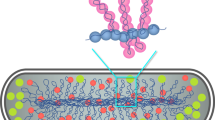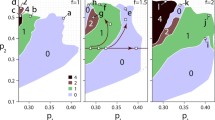Abstract
The Lifshitz equation for the confinement of a linear polymer in a spherical cavity of radius R has the form of the Schrödinger equation for a quantum particle trapped in a potential well with flat bottom and infinite walls at radius R. We show that the Lifshitz equation of a confined annealed branched polymer has the form of the Schrödinger equation for a quantum harmonic oscillator. The resulting confinement energy has a 1/R4 dependence on the confinement radius R, in contrast to the case of confined linear polymers, which have a 1/R2 dependence. We discuss the application of this result to the problem of the confinement of single-stranded RNA molecules inside spherical capsids.





Similar content being viewed by others
Notes
To help the reader, we provide here details of this “translation”. Suppose that the external potential φ2(r) is zero inside a sphere of radius R ≫ a and very large (infinite) outside. Replacing \(\hat {g} \simeq 1 + (a^{2}/6) \nabla ^{2}\), (2) becomes
$$\left( 1 - \frac{1}{p^{\ast}} \right) \tilde{\psi} = - \frac{a^{2}}{6} \nabla^{2} \tilde{\psi} . $$The Schrödinger equation inside such a potential well reads
$$\epsilon \psi = - \frac{\hbar^{2}}{2 m} \nabla^{2} \psi . $$From the known ground state energy for the quantum case, we can find p∗ by replacing \(\hbar ^{2}/2m \to a^{2}/6\) and 𝜖 → 1 − (1/p∗). This gives 1/p∗ = 1 − Ca2/3R2. Using formula (1), one finds a confinement free energy Ω = N lnp∗≃ Ca2/3R2.
In the original equations derived in the work [16] and also reproduced in [15], (3a) include also factors Λ1 and Λ3—the fugacities of the end-points and branch-points, respectively. For the system at hand, this is not necessary, because for any tree the number of ends is always equal to the number of branched points plus two: they are the same in large N limit. In the earlier paper [15], we got rid of these factors by a simple re-naming of variables. In a more general situation, where one may have one, two- and three-valent units in the polymer, i.e., our building set includes both dimers of Fig. 1 and trimers of Fig. 3, then we need Λ1, Λ2, and Λ3 to control relative abundance of these building blocks.
In order to obtain this result, start from (1) and insert it into the left hand side of (8). Recall that \(p^{\ast }_{\text {free}} = 1/2\) and Ωfree = −N ln 2 and insert this into the first term in the right hand side. One finds that \(1/p^{\ast } = 2 e^{-\varphi _{0} - \omega } \simeq 2 e^{-\varphi _{0}} \left (1 - \omega \right )\). Insert this into (3a) and (3b) with external potentials (6) and replace \(\hat {g} \to 1 + (a^{2}/2D) \nabla ^{2}\).
References
Yoffe, A.M., Prinsen, P., Gopal, A., Knobler, C.M., Gelbart, W.M., Ben-Shaul, A.: Predicting the sizes of large RNA molecules. Proc. Natl. Acad. Sci. 105, 16153 (2008)
Fang, L., Gelbart, W., Ben-Shaul, A.: The size of RNA as an ideal branched polymer. J. Chem. Phys. 135, 155105 (2011)
de Gennes, P.-G.: Statistics of branching and hairpin helices for the dat copolymer. Biopolymers 6, 715–729 (1968)
Perlmutter, J.D., Qiao, C., Hagan, M.F.: Viral genome structures are optimal for capsid assembly. eLife 2, e00632 (2013)
Singaram, S.W., Garmann, R.F., Knobler, C.M., Gelbart, W.M., Ben-Shaul, A.: Role of RNA branchedness in the competition for viral capsid proteins. J. Phys. Chem. B 119, 13991–14002 (2015)
Erdemci-Tandogan, G., Wagner, J., van der Schoot, P., Podgornik, R., Zandi, R.: RNA topology remolds electrostatic stabilization of viruses. Phys. Rev. E 89, 032707 (2014)
Erdemci-Tandogan, G., Wagner, J., van der Schoot, P., Podgornik, R., Zandi, R.: Effects of RNA branching on the electrostatic stabilization of viruses. Phys. Rev. E 94, 022408 (2016)
Li, S., Erdemci-Tandogan, G., Wagner, J., van der Schoot, P., Zandi, R.: Impact of a nonuniform charge distribution on virus assembly. Phys. Rev. E 96, 022401 (2017)
Li, S., Orland, H., Zandi, R.: Self consistent field theory of virus assembly. ArXiv e-prints (2017)
Bruinsma, R.F., Comas-Garcia, M., Garmann, R.F., Grosberg, A.Y.: Equilibrium selfassembly of small RNA viruses. Phys. Rev. E 93, 032405 (2016)
Hofacker, I., Fontana, W., Stadler, P., Bonhoeffer, L., Tacker, M., Schuster, P.: Fast folding and comparison of RNA secondary structures. Monatsh. Chem. (Chemical Monthly) 125, 167–188 (1994)
Kelly, J., Grosberg, A.Y., Bruinsma, R.: Sequence dependence of viral RNA encapsidation. J. Phys. Chem. B 120, 6038–6050, (2016)
Gopal, A., Zhou, Z., Knobler, C.M., Gelbart, W.M.: Visualizing large RNA molecules in solution. RNA 18, 284–299 (2012)
Garmann, R., Comas-Garcia, M., Gopal, A., Knobler, C.M., Gelbart, W.M.: The assembly pathway of an icosahedral single-stranded RNA virus depends on the strength of inter-subunit attractions. J. Mol. Biol. 426, 1050–1060 (2013)
Grosberg, A.Y., Kelly, J., Bruinsma, R.: The confinement of an annealed branched polymer by a potential well. Low Temp. Phys. 43, 101–109 (2017)
Grosberg, A.Y., Gutin, A., Shakhnovich, E.: Conformational entropy of a branched polymer. Macromolecules 28, 3718–3727 (1995)
Grosberg, A.Y., Khokhlov, A.R.: Statistical Physics of Macromolecules. American Institute of Physics Press, New York (1994)
Lifshitz, I.M.: Some problems of the statistical theory of biopolymers. Zh. Eksp. Teor. Fiz. 55, 2408–2422 (1968)
Parisi, G., Sourlas, N.: Critical behavior of branched polymers and the lee-yang edge singularity. Phys. Rev. Lett. 46, 871–874 (1981)
Gutin, A.M., Grosberg, A.Y., Shakhnovich, E.I.: Polymers with annealed and quenched branchings belong to different universality classes. Macromolecules 26, 1293–1295 (1993)
Grosberg, A., Nechaev, S.: From statistics of regular tree-like graphs to distribution function and gyration radius of branched polymers. J. Phys. A: Math. Theor. 48, 345003 (2015)
Rosa, A., Everaers, R.: Computer simulations of randomly branching polymers: annealed versus quenched branching structures. J. Phys. A Math. Theor. 49, 345001 (2016)
Everaers, R., Grosberg, A.Y., Rubinstein, M., Rosa, A.: Flory theory of randomly branched polymers. Soft Matter 13, 1223–1234 (2017)
Kelly, J.: Physics of Complex Polymeric Molecules, Ph.D. thesis, UCLA. https://escholarship.org/uc/item/9hk3m75p (2017)
Acknowledgments
RB would like to acknowledge support from the National Science Foundation under DMR Grant 1309423. The work of AYG was supported partially by the MRSEC Program of the National Science Foundation under Award Number DMR-1420073. RB and AYG thank the Aspen Center for Physics where part of this work was done with the support of the National Science Foundation under Grant No. PHY-1066293.
Author information
Authors and Affiliations
Ethics declarations
Conflict of interest
The authors declare that they have no conflict of interest.
Rights and permissions
About this article
Cite this article
Grosberg, A.Y., Bruinsma, R. Confining annealed branched polymers inside spherical capsids. J Biol Phys 44, 133–145 (2018). https://doi.org/10.1007/s10867-018-9483-x
Received:
Accepted:
Published:
Issue Date:
DOI: https://doi.org/10.1007/s10867-018-9483-x




